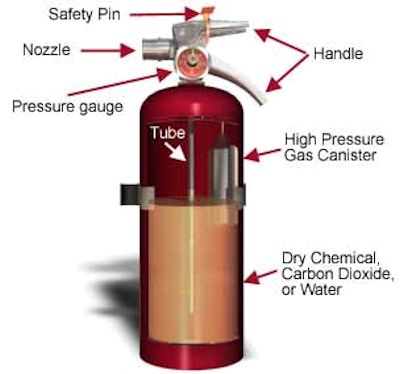Fire Extinguishers
Be sure to inspect all fire extinguishers to ensure that extinguishers are available and ready for use. For more information see: 29 CFR 1910.157, National Fire Protection Association Standard 10, and American Petroleum Institute (API) Recommended Practice 54.
Parts of a Fire Extingusiher

Location
Write the location of each fire extinguisher on the form.
- Verify that the location of each fire extinguisher protects the unit from damage or contamination during normal rig operations and from the environment.
- Verify that fire extinguishers are easily accessible in case of emergency.
- Fire extinguishers should be stored off the deck (ground) to reduce corrosion to the bottom.
Types
Write the brand and type of extinguisher on the form. This will ensure that the extinguishers are in the correct locations.
Nameplates
- Check that the nameplate that faces outward, is clear and legible, and includes operating instructions.
Seals
- Check the seal or other tamper indicator on the trigger which provides an indication if the unit has been used or damaged.
- If the seal has been broken or is missing, make sure the unit has been fully serviced and resealed.
Tags
- Check that the yearly inspection tag is marked with the year and month of the last recharge inspection.
- If the tag is missing, or if the unit is in need of its annual inspection, make sure it is removed from use and a servicing is scheduled.
Condition
Inspect the exterior of the unit for damage and corrosion. Pay close attention to the bottom of the tank for rust and corrosion as this area tends to be susceptible to water and chemical damage if it has been stored on the floor. Remember to store extinguishers off the deck. The hose should be checked to see that it is properly installed, undamaged, and clear. The trigger assembly should also be checked for damage and serviceability.
- FULL (visual indicator): Inspect the pressure gauge and check that the needle is in the green and charged. Also check to see that the gauge is not bent or broken.
- FULL (dry chemical type): Take the unit out of the rack and tip the unit back and forth to determine if it has loose powder inside. Occasionally it may be necessary to invert and tap the base to loosen the powder. Use your hand, or a rubber mallet to tap the extinguisher.
- WHEEL UNIT: Check the condition of the tires, the carriage, the hose and nozzle.
Knowledge Check Choose the best answer for the question.
1-9. Why should fire extinguishers be stored off the deck (ground) of the rig?
You forgot to answer the question!
